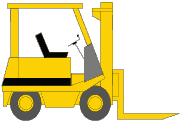![]()
AN OWNER'S GUIDE TO MAINTAINING, SERVICE AND REDUCE THE OPERATING COST OF A FORKLIFT FLEET.


Are you losing money on your lift trucks?
A fleet manager's goal should be to run the fleet at
lowest total cost and highest productivity compared to the industry. If a manager can know his costs and how they
compare to the industry on every one of his trucks he'll know whether or not he's losing money on his fleet of
trucks.
There are three things fleet managers should collect
on a monthly basis on each truck in their fleet:
The sad truth of the matter is, most fleet managers don't know if they're getting
the most bang from their lift truck buck because they're not tracking those three pieces of information. And that
means they're probably losing money. When you look at the data, just how much money is lost each year can be staggering.
According to industry estimates, there are 1 million Class 1, 4 and 5 lift trucks in North America. More than half
of them have exceeded their economic life, which is the point at which a truck reaches its lowest total cost of
maintenance and ownership compared to the entire industry.
The average electric truck is being traded in at 26,000 hours. The average internal combustion truck gets traded
in at 22,500 hours. Most lift truck manufacturers have found that the best time to trade-in lift trucks is at 10,000
to 12,000 hours. In other words, on a truck that runs an average of 2,000 hours a year, it's being kept in a fleet
for anywhere from five to six years beyond its economic life.
Ninety percent of lift truck users will tell you that they do not collect parts costs, labor costs and meter readings.
Out of the 500,000 trucks that have exceeded their economic life, about $1 billion in excess maintenance costs
have been wasted because there's $25 billion in rolling assets in North America that have exceeded their economic
life. Since 90 percent of the companies don't collect parts and labor costs and meter readings, they are unaware
that they're losing so much money.
The numbers don't lie. Do you know how much time your trucks
run per shift? Per day? Per week, month, or quarter? If so, how do
you know? Many managers assume that the trucks in their fleet are operating at 70 to 80 percent utilization. For
every 8-hour shift, they believe their trucks run about six hours. But the average utilization in North America
is only 25 percent.
Most people are fooled because they don't keep accurate information. They assume that their utilization is 70 percent
to 80 percent. You can't get 70 percent utilization out of a truck that's six years old or older. The way to get
accurate information is to take hour-meter readings, not by relying on what your operators or your instincts tell
you. Consider the example of a grocer with a fleet of 500 lift trucks. The grocer was thinking about including
200 of his trucks on National Services monthly reporting service to track parts and labor costs.
When asked why he didn't want to include the other 300 trucks.He said that those were pallet jacks. They considered
them throw-away trucks. But when he investigated further, he discovered that the company rarely, if ever, discarded
any of the old trucks. Some pallet jacks still in service dated back to the 1960s. After checking the maintenance
records on two of the trucks, the grocer discovered that over the past 30 years, he had spent $265,000 in maintenance
and repairs. The cost to replace the trucks today would be about $7,500.
Companies who try to stretch too many hours out of their equipment are the rule, not the exception. In some cases,
companies spend $5,000 to $10,000 every year to maintain a truck that would cost just $18,000 to replace. Managers
who don't track engine hours per year and keep records of how much it costs for maintenance and repairs aren't
aware of how much money they're wasting.
The best fleet managers are the ones who know when to get rid of their trucks at the lowest total cost or the economic
break-even point. If they know that, they can run a fleet that's leaner, at lower cost and at higher utilization.
Determining the economic break-even point of a lift truck:
At some point in time, because of rising maintenance costs, it makes more sense
to get rid of an old lift truck than to continue to keep it running. That's called the economic break-even point.
In order to determine a truck's break-even point, you first must know the truck's cost-per-hour. To determine a
truck's cost-per-hour, add the total parts cost to the total labor costs and divide by the number of hours of operation.
The break-even point signifies the lowest obtainable cost per hour that the truck can achieve during its lifetime.
Let's say that the break-even point on a truck is $2.50 per hour. If you run the truck at $3.50 per-hour, you're
spending $1 more every hour than you should or could be spending. Depending upon how many hours you operate that
truck, you can calculate how much money you could save if you'd replace the truck.
The most important thing for a fleet manager to
know today is not the best price to pay for a new truck. The most important thing to know is when it's time to
get rid of that truck.
Productivity magazine

FORKLIFT OPERATION AND
SERVICE.
BE SURE TO VISIT THE HOME PAGE FOR INFORMATION ON LIFT TRUCKS REPAIR,
SERVICE, TROUBLESHOOTING, AND EVERYTHING YOU NEED TO KNOW ABOUT FORKLIFTS AND THEIR USE.